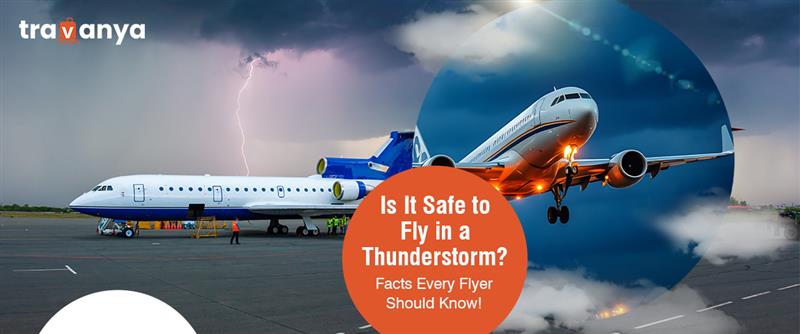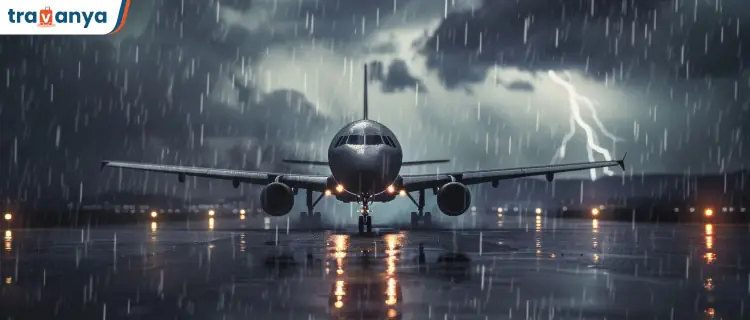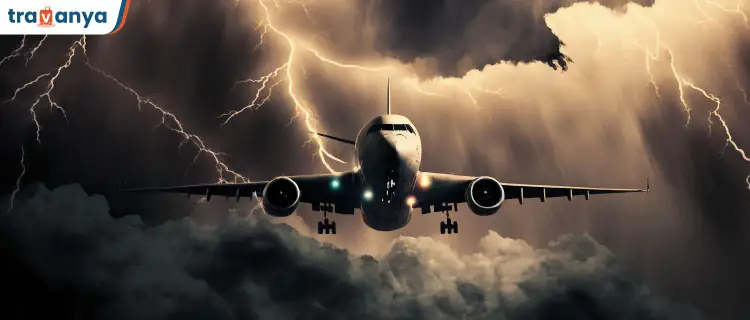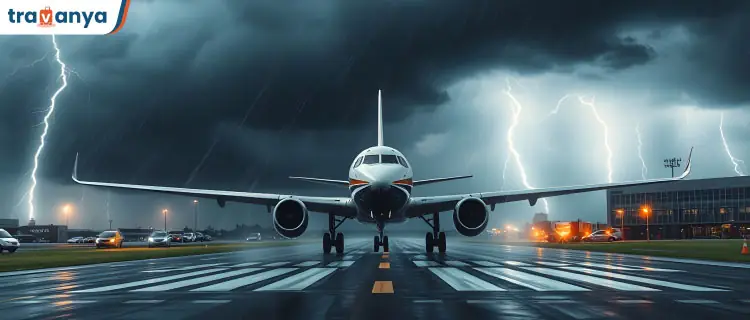
Is It Safe to Fly in a Thunderstorm? Facts Every Flyer Should Know!
Posted on Wednesday, June 11th, 2025 by Neha Sharma Leave a Comment
Ever been caught in a thunderstorm and thought, ‘Wow, I’m glad I’m not up in the air right now!’? It’s a pretty common feeling. We all know thunderstorms pack a serious punch – lightning, wind, hail… But what about airplanes? Can those metal tubes fly through that kind of chaos? The answer isn’t as simple as you might think, so let’s buckle up and explore whether planes and thunderstorms can ever be friends (or at least, avoid becoming enemies).
Can Planes Fly in Thunderstorms?
Yes, planes can fly in thunderstorms. Aircraft are built to handle severe weather, and pilots are trained to navigate challenging conditions. However, flying in a thunderstorm is not something pilots take lightly. They use advanced weather radar and real-time data to avoid the most severe parts of a storm, such as the core of a thunderstorm or the turbulent zones. So, while thunderstorms don’t necessarily stop flights, they do require pilots to exercise extreme caution.
The Role of Lightning and Thunder in Flight Safety
A common concern during thunderstorms is lightning. Can lightning hit a plane? The answer is yes, but it’s much less dramatic than people think. Planes are designed with lightning protection built right into them.
Modern aircraft are made of materials that can withstand lightning strikes, and in most cases, when lightning hits a plane, it simply travels along the exterior without causing any damage. The plane’s metal structure conducts the electricity, preventing it from affecting the interior of the aircraft or the passengers.
In fact, planes are struck by lightning more often than you might think. On average, a commercial jet is hit by lightning about once every 1,000 flight hours. But despite this, flying in a thunderstorm is safe.
Aircraft manufacturers & aviation authorities ensure that planes are tested & certified to withstand these occurrences. Lightning on a plane is more of a non-issue for the aircraft’s integrity, although it might be a shocking experience for passengers onboard!
Can a Plane Take Off or Land in Rain?

Another common concern is whether a plane can take off in the rain or land in the rain. The answer is a definite yes! Rain does not prevent flights from taking off or landing, as long as visibility & runway conditions are suitable.
Airports have instruments that help pilots land safely in rainy conditions, including precision landing systems that guide the aircraft down to the runway, even when it’s heavily raining.
That said, tropical storms or heavy thunderstorms can make takeoff or landing more difficult. These storms may have winds strong enough to affect an aircraft’s performance, but pilots will always avoid areas of extreme weather.
If conditions are deemed unsafe, flights will be delayed, diverted, or canceled, but this is to prioritize passenger safety.
Do Planes Fly Above Storms?

Can planes fly above thunderstorms? Absolutely! Commercial jets typically cruise at altitudes of around 30,000 to 40,000 feet, well above most weather systems. Thunderstorms generally occur below this cruising altitude, & pilots can often fly above storms to avoid the turbulence and dangerous conditions associated with them.
This is why, even if you’re flying during a storm, you might notice smooth air once the plane reaches its cruising altitude.
However, it’s important to note that thunderstorms can extend to great heights – sometimes up to 60,000 feet! In such cases, pilots may need to reroute the flight, either diverting around the storm or altering altitude as needed.
What Happens if a Plane is Struck by Lightning?

While rare, the possibility of an aircraft being struck by lightning does exist. However, the risks are very minimal. Aircraft are built with lightning protection systems, including conductive materials like aluminum, which allow lightning to flow through the plane’s exterior without damaging critical systems.
In the rare event of a lightning strike, the plane’s electronics and systems are designed to function normally, as modern aircraft have sophisticated shielding.
Interestingly, lightning incidents rarely cause any injuries to passengers or crew. Aircraft are also equipped with multiple backup systems, ensuring that even in the unlikely event of an electrical failure, the plane can still be safely controlled.
So, flying through thunderstorms or even being struck by lightning does not pose a serious risk to the plane’s operation.
What Can Passengers Do for Their Safety?

As a passenger, there are several things you can do to ensure your safety when flying in thunderstorms or experiencing turbulence:
- Buckle Up: The most important thing you can do is keep your seatbelt fastened during the flight. Thunderstorms can cause turbulence, and while it’s not dangerous, it can be uncomfortable. Staying seated and buckled ensures your safety.
- Listen to the Crew: Pay attention to any instructions from the flight attendants or captain. They will provide information if the weather is particularly severe or if any changes to the flight plan are necessary.
- Stay Calm: Thunderstorms can be frightening, but remember that flying in thunderstorms is safe. Planes are built to handle extreme weather, and pilots are highly trained to navigate challenging conditions.
- Know the Storm’s Path: If you’re nervous about flying during a storm, you can track the storm’s path through weather apps or flight trackers to understand how the plane is avoiding it or what alternate routes may be taken.
Conclusion: Flying in Thunderstorms is Safe, But Requires Careful Navigation
In conclusion, while planes can fly in thunderstorms, there are various factors that pilots & flight crews take into account to ensure passenger safety. From lightning protection in aircraft to flying above storms, modern aviation technology makes it possible for flights to operate safely even in severe weather conditions. While the thought of lightning hitting a plane or flying through a storm might sound scary, remember that aircraft are built to withstand these events, & your safety is always the top priority.
FAQs
Q: Do airlines cancel flights during thunderstorms?
A: A: Not always. Airlines only cancel flights during thunderstorms if it’s unsafe to fly or if airport operations are affected. For example, if there’s heavy lightning near the runway, the ground crew can’t work, which delays boarding, fueling, or baggage handling. If delays extend for too long, flights may get rescheduled or canceled.
Q: Can planes take off or land in tropical storms or hurricanes?
A: A: No, commercial planes do not take off or land during tropical storms or hurricanes. These storms come with extreme winds, turbulence, and poor visibility that make flying dangerous. Airlines usually cancel flights in advance and reroute traffic around these systems for everyone’s safety.
Q: What happens to flights during a red alert for weather?
A: A: A red weather alert signals severe conditions such as thunderstorms, hail, or wind shear. In such cases, airports may halt operations, & airlines delay or cancel flights. Passengers are notified via email, SMS, or airline apps, and rebooking options are usually offered at no extra cost.
Q: Can a plane get damaged by lightning?
A: A: Yes, but very rarely. Planes are designed with lightning protection systems like conductive aluminum skin & static discharge wicks. When lightning hits, it travels along the aircraft’s surface & exits safely. Major damage is extremely rare, and if it happens, it’s usually cosmetic and handled after landing.
Q: What happens if a plane is hit by lightning mid-air?
A: A: If a plane gets struck mid-air, passengers might see a flash or hear a loud bang. But don’t worry – pilots are trained for it, & the aircraft is built to handle it. After the strike, the pilot will check systems & report them to maintenance crews on landing for inspection.
Q: Why do airports delay flights even if it’s only raining?
A: A: Because rain affects more than just the flight itself. Slippery runways, limited visibility, & lightning risks for the ground crew can all lead to delays. Even if the plane can fly, if the baggage can’t be loaded or fueling can’t be done due to lightning, the flight gets pushed back.
Q: How do pilots avoid flying through severe thunderstorms?
A: A: Pilots use onboard radar & air traffic control guidance to reroute around thunderstorms. Most flights are adjusted in real-time to fly around or above storm cells. Modern aircraft have excellent weather detection systems that help avoid turbulent zones safely.
Q: What do the flashing lights on a plane do during bad weather?
A: A: The lights on a plane—navigation lights, strobe lights, and anti-collision lights—help increase the plane’s visibility to other aircraft, especially in poor weather. They don’t protect against storms, but play a role in keeping the aircraft visible & safe while flying in rain or fog.
Q: Do pilots have special training for flying in thunderstorms?
A: A: Absolutely! Pilots undergo rigorous simulator training for extreme weather, including thunderstorms, wind shear, lightning, & low visibility. They’re trained to respond calmly and correctly using checklists and real-time coordination with air traffic control.
About Neha Sharma View All Posts
Neha Sharma, a passionate travel blogger, captures the beauty of the world through her words. With her adventurous spirit and a keen eye for detail, Neha takes her readers on mesmerizing journeys to exotic destinations. Her vivid descriptions and insightful tips make her the go-to guide for wanderlust seekers. Join Neha as she explores the globe, sharing her love for travel and inspiring others to go on their unforgettable adventures.


Leave a Comment